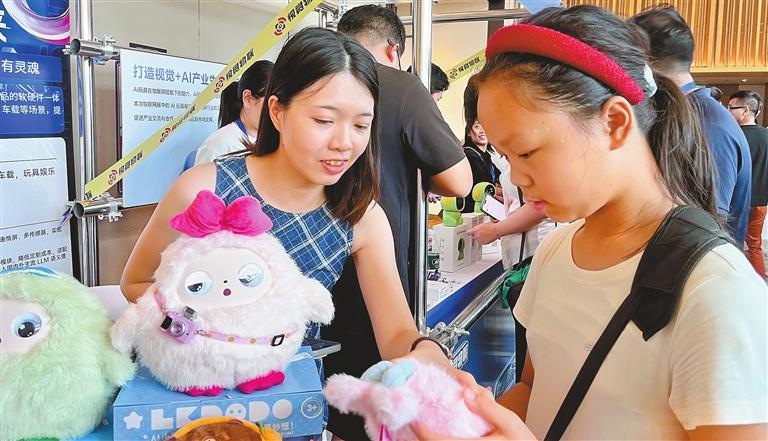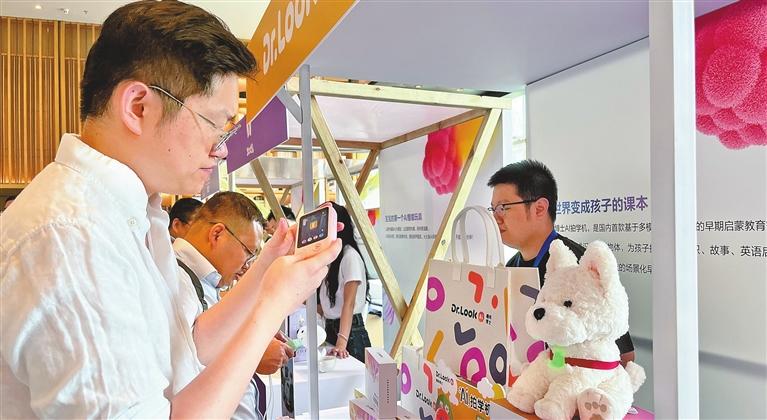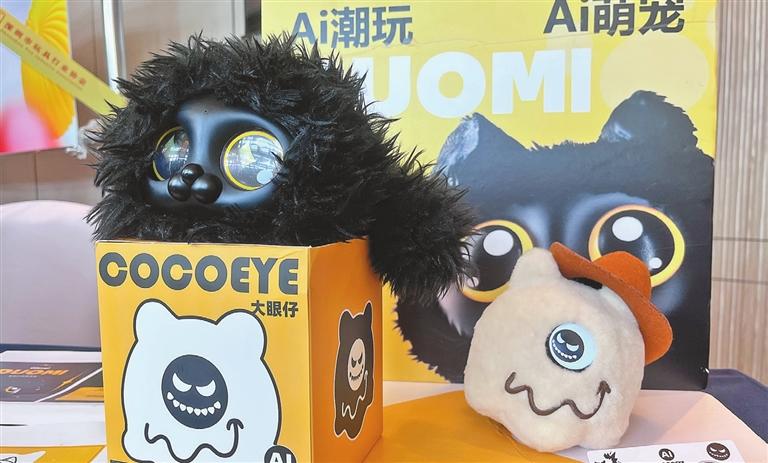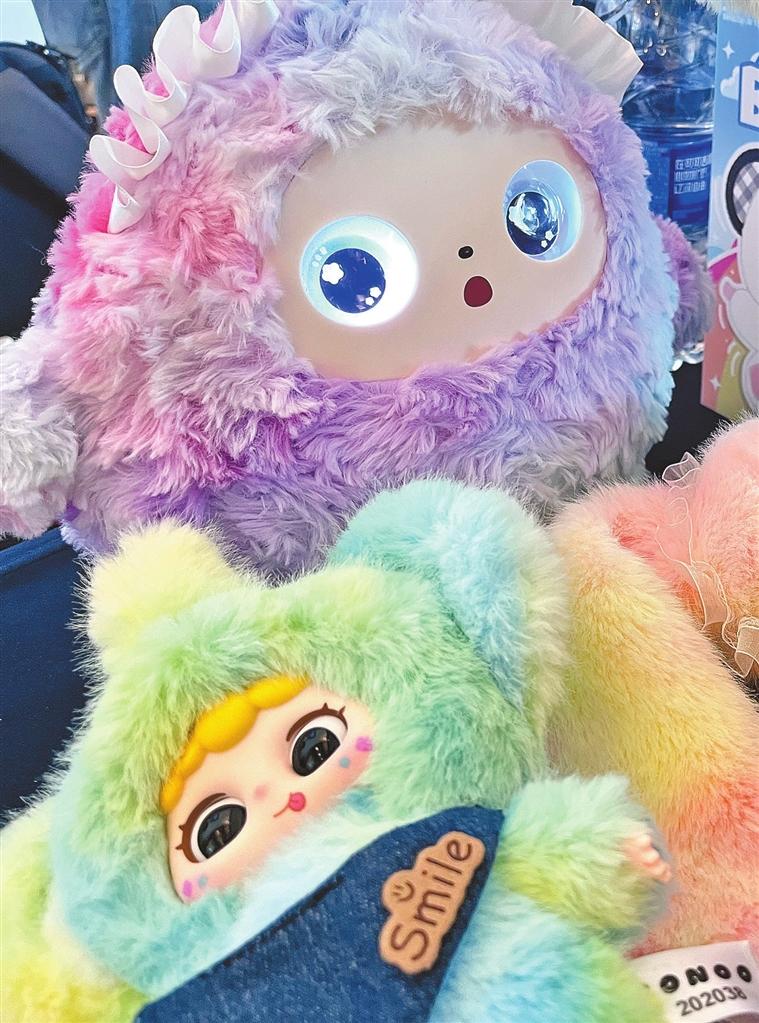



Zhang Yu JeniZhang13@163.com IN a move that signals a seismic shift in the global toy industry, OpenAI — the San Francisco-based artificial intelligence powerhouse — announced in June a strategic partnership with Mattel, the iconic maker of Barbie dolls, Hot Wheels, and UNO. Many technology giants, traditional toy manufacturers, and internet companies have also laid out their strategies in the face of the emerging AI toy market. Also in June, Coze Studio, an open-source AI agent development platform by ByteDance, unveiled an AI development kit called EchoEar, which is suitable for voice interaction products that require large model empowerment, such as toys, smart speakers, and smart central controls. At the recently concluded World Artificial Intelligence Conference 2025, Chinese e-commerce giant JD.com released its intelligent brand JoyInside, which aims to provide large model-driven dialogue capabilities for intelligent terminals such as robots and AI toys. Also at the conference, ZTE unveiled its AI pet Mochi, which focuses on emotional companionship. These moves reflect a broader trend: companies across sectors are recognizing the potential of AI to redefine play. From conversational companions to emotionally responsive pets, the market is rapidly diversifying, and each player is aiming to capture a share of this high-growth frontier. From static entertainment to dynamic interaction For centuries, toys have been a cornerstone of childhood — simple objects designed to entertain, educate, and inspire imagination. From carved wooden animals to wind-up tin robots, the earliest toys were fundamentally static. They relied entirely on a child’s mind to bring them to life, with children projecting narratives, emotions, and personalities onto their toys. The first major leap toward dynamic play probably came with the introduction of electronics into toys. Starting in the late 20th century, toys began to incorporate batteries, lights, sounds, and simple mechanics. Although these toys followed programmed paths and offered limited responses, they planted the seeds for what was to come: the idea that a toy could be a responsive entity. Today, a new generation of toys is changing the rules of play. These are not just objects, but dynamic companions — toys that listen, learn, respond, and even feel. A real turning point has come with AI, which enables toys to move beyond pre-programmed responses into genuine dynamic interaction. These toys can recognize voices and faces, hold natural conversations, adapt to a child’s learning pace, remember past interactions, and simulate emotional responses. Dr.LookAI, an AI hardware brand established last year by Shenzhen-based AI chip and algorithm company Intellifusion, is aimed at helping children explore the world through AI technology. The company has invested in the research and development of two AI hardware products: an AI learning camera and an AI plush toy. Designed for children aged 3 and above, the AI learning camera employs multimodal recognition to enable interactive, scenario-based learning. “Since its launch nearly six months ago, the AI learning camera has become a top performer, consistently ranking within the top 10 of the entire toy category on Douyin,” a staffer with Dr.LookAI told Shenzhen Daily. “In fact, it significantly outsells other cameras on the market. To be precise: it is Douyin’s best-selling toy camera, making it one of the most popular products in its category,” the staffer added. The AI plush toy, ready to hit the market in two months, combines a multimodal large model with an emotional interaction system, enabling it to respond to voice, images, and other inputs for engaging feedback. “They’re not just for children to play. More importantly, they can help children learn through play,” the staffer noted. IP+tech: Two-way empowerment At the heart of the Mattel-OpenAI alliance is a symbiotic relationship between content and computation. Mattel brings beloved characters and narratives that have shaped childhoods for generations, and OpenAI brings the brains to make those characters come alive. This fusion enables what industry insiders are calling “anthropomorphic interaction” — toys that behave with human-like traits. A doll powered by GPT can comfort a child when they’re sad, engage in creative storytelling, or help with homework through conversational tutoring. This leap in functionality redefines the value chain of the toy industry, shifting the focus from manufacturing to intelligent experience design. In the AI toy sector, the triad of technology, content, and IP forms the foundation of product development. Zhejiang Jinke Tom Culture Industry Co. Ltd. knows the market inside and out. Following the global sensation of the video game “Talking Tom Cat,” developed by Slovenian company Outfit7 in 2010, the Hangzhou-based Chinese company has developed a roster of six characters spun off from the original — Talking Tom, Angela, Hank, Ben, Ginger, and Becca — thereby establishing the Talking Tom & Friends IP matrix. “We secured the global IP back in 2014-2015. Building on that, we rolled out games and animations, successfully establishing a full-fledged brand,” said Yu Xiang, a staffer with the company. Capitalizing on the growing trend of merging AI with edutainment, the company began transforming its beloved “Talking Tom” into a more interactive version. The culmination of this effort was the December 2024 debut of their first AI companion robot. Leveraging an innovative “AI+IP” model, the robot is equipped with a suite of practical features, including the ability to initiate conversations, recognize emotions, provide educational content on a wide range of topics, and teach English. This AI toy was named one of Hangzhou’s Top 10 “New Sci-Tech Specialties” for 2025. The core value of AI toys Beyond novelty, the most compelling value proposition of AI toys lies in their ability to meet emotional needs. This phenomenon taps into the broader “loneliness economy,” where consumers — across age groups — seek connection and companionship through technology. AI toys, with their capacity for “active dialogue” and “emotional resonance,” are uniquely positioned to fill this gap. In children’s education, they can act as personalized tutors. For adults, they can serve as stress-relief companions. In elder care, AI-powered robotic pets or dolls can offer comfort and cognitive engagement, especially to seniors living alone. The emotional layer transforms the toy from a product into a service — one that evolves with the user and deepens its value over time. “Our first product Duomi, which is for adults, has 14 facial expressions that can be changed according to the emotional needs of the user during conversation,” said Cher Zhou, the team leader of AI product development at Shenzhen-based startup Aimaker. Zhou said that the company has already received orders from countries such as Japan and South Korea. “When it comes to these kinds of robotic toys, Japan is a very receptive market. They’ve already had similar products out for a year or two, so people there are used to the idea,” Zhou told Shenzhen Daily. “On top of that, you have some big social trends driving this. The ‘solo economy’ is huge, as a lot of young people feel lonely and want companionship, and there’s also a massive need from seniors for someone to interact with or help them out,” she added. Reshaping business models The sector’s potential is underscored by the “AI Toy Industry White Paper” (JD.com & Shenzhen Toy Industry Association), which projects China’s AI toy market to exceed 10 billion yuan (US$1.39 billion) by 2030, growing more than 70% annually. The infusion of AI into toys is also catalyzing a profound shift in business models. As toys transition from “passive interaction” to “active companionship,” their dependence on advanced hardware — sensors, speakers, cameras, and connectivity chips — grows. This creates opportunities for hardware innovation and integration. He Xiaodong, vice president of JD.com and deputy managing director of JD AI Research, noted that many companies are already great at the ‘cerebellum’ part — they can build robots that do amazing physical tricks, like somersaults. But the ‘brain’ is different. It’s about using powerful AI models so robots can actually talk with people, provide friendly companionship, and even teach. “This is something most companies can’t do yet, and that’s the gap JD’s JoyInside is designed to fill,” He said. Moreover, toy companies like Mattel can evolve from mere manufacturers into platform operators. By integrating AI algorithms, third-party content, and even developer ecosystems, they can create a networked environment where their toys serve as gateways to a broader universe of digital experiences. While the potential is immense, the rise of AI toys also raises important questions around privacy, data security, screen time, and the ethical implications of anthropomorphic machines. How much data should a toy collect? Who owns that data? And, what are the psychological effects of children forming deep attachments to AI? | 
